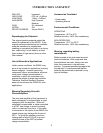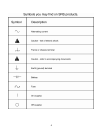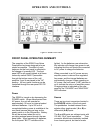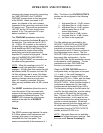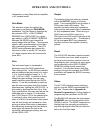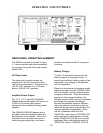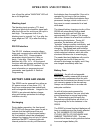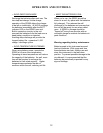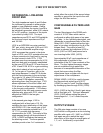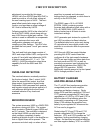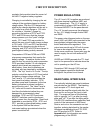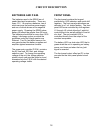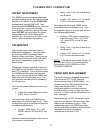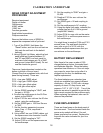
OPERATION AND CONTROLS
11
turn off and the yellow "MAINTAIN" LED will
be on full brightness.
Blanking Input
The blanking input accepts a TTL-level
signal and grounds the amplifier signal path
after the front end for as long as the input is
held high. The response time of the
blanking input is typically "on" 5 µs after the
rising edge and "off" 10 µs after the falling
edge.
RS-232 Interface
The RS-232 interface connector allows
listen-only communication with the SR560
at 9600 baud, DCE. Communication
parameters should be set to 8 bits, no
parity, 2 stop bits. Data sent must be
delimited by <CR> <LF>. All front panel
functions excluding power and blanking, are
available over the RS-232 interface. For
more information on programming and
commands, see Appendix A: Remote
Programming.
BATTERY CARE AND USAGE
The SR560 can be powered from either an
AC power source or from three 12 V, 1.9
Amp-hour maintenance-free sealed lead-
acid rechargeable batteries. Integral to the
SR560 is an automatic battery charger,
along with battery protection and charge
indication circuitry.
Recharging
During battery operation, the front panel
BATT LED will change from green to red to
indicate that the batteries are low and
require charging. For the longest battery
life, the batteries should be immediately
charged by plugging the unit into AC power
whenever the BATT indicator lights red.
Internal protection circuitry will disconnect
the batteries from the amplifier if the unit is
operated for too long in the low battery
condition. This protects the batteries from
permanent damage, which could occur if
they were to remain connected to a load
while dead.
The internal battery charging circuitry of the
SR560 will automatically charge dead
batteries at a quick rate until they are
approximately 80% charged. The charge
rate is then lowered to a level that is safe for
maintaining the batteries. During AC
operation, the batteries will be in this
"maintain" charge condition indefinitely, and
will suffer no degradation from prolonged
charging. The sealed lead-acid batteries
used in the SR560 differ in this respect from
nickel-cadmium batteries, which do suffer
shortened lifetimes due to overcharging.
The sealed lead-acid batteries will provide
the longest service life if they are not
allowed to discharge too deeply and if they
are charged immediately after use.
Battery Care
WARNING
: As with all rechargeable
batteries, for safety reasons the chemical
recombination processes within the cells
require that the batteries be allowed to vent
non-corrosive gases to the atmosphere.
Always use the batteries in an area with
adequate ventilation.
As with all instruments powered by
rechargeable batteries, the user must take
some precautions to ensure long battery
life. Understanding and following the
precautions outlined below will result in a
long operating life for the batteries in the
SR560.
The SR560's internal lead-acid batteries will
have a variable service life directly affected
by THE NUMBER OF DISCHARGE
CYCLES, DEPTH OF DISCHARGE AND
AMBIENT TEMPERATURE. The user
should follow these simple guidelines below
to ensure longest battery life.



